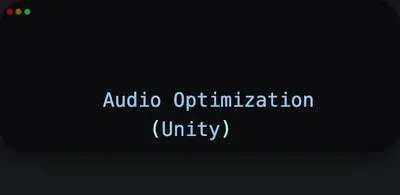Back To Home

Optimization
24-04-2024
Make Your Game Sound Awesome (Without Making it Crash!)
"Want cool sound effects and music in your Unity game, but worried it might make things laggy? Don't worry! This guide will show you some simple ways to keep your game sounding great without slowing it down."

Audio System :-
-
Audio plays a vital role in creating an immersive user experience. Typically, games incorporate various audios, and managing them across platforms can be challenging. Most games feature background music and sound effects.
Sound effects are brief clips that accompany actions in the game, such as gunfire when the player shoots, while music clips are longer. Unity offers audio functionality to integrate sound effects and music into games. It can import and play various audio file formats, adjust sound volume, and handle sounds playing from specific positions within the scene.
Audio bottlenecks can arise from various sources, including excessive compression, audio manipulation, active audio components, inefficient memory storage methods, and access speeds, all leading to poor memory and CPU performance.
So, let's learn some useful tricks to avoid a user experience disaster.
Understanding the Audio System :-
Audio Clips :
These are the individual sound files you import into your project, such as music tracks, explosions, or character footsteps. Unity supports various formats like MP3, WAV, and OGG.Audio Sources :
These act as the sound emitters within your game world. You attach Audio Sources to game objects, defining where the sound originates and how it behaves (volume, pitch, etc.).Audio Mixer :
This is the central hub for managing your soundscape. Use the mixer to adjust volume levels, add effects (reverb, echo), and create a cohesive audio experience.
The Journey of a Sound: How Audio Comes Alive :-
Importing Audio Clips :
Bring your desired sound files into your Unity project.Attaching an Audio Source :
Add an Audio Source component to the game object that will emit the sound.Assigning the Audio Clip :
Within the Audio Source component, link the imported audio clip.Playing the Sound :
Utilize scripting or built-in Unity functions to trigger the Play() method on the Audio Source, making the sound come alive.
Playing a sound in Unity involves a few key steps :
Loading Audio Files :-
Preload Audio Data :
When enabled, each audio clip assigned to an AudioSource in the scene loads into memory during scene initialization. This immediate reference to files in the scene increases loading time.Disabling Preload Audio Data :
Instructs Unity to skip audio file asset loading during scene initialization, speeding it up. However, the first time we play the file, the CPU needs immediate access to the disk, retrieving the file, loading it into memory, decompressing it, and playing it, blocking the main thread until completed.Load In Background :
his option changes audio loading into an asynchronous task, preventing it from blocking the main thread. However, the file won't be ready to play until loading completes on a separate thread.
Initially, our audio files are packaged as binary data files bundled with our application, residing on the device's hard disk. Loading audio data involves pulling it into the main memory (RAM) for later processing by audio decoders, converting the data into audio signals for headphones or speakers. However, loading methods vary based on three settings:
Load Type :-
Unity offers the Load Type option, dictating how audio data loads when it occurs, with three available options:
Decompress On Load
Compressed In Memory
Streaming

Encoding Formats and Quality Levels :-
Unity supports three encoding formats for audio clips:
-
Compressed
-
PCM
-
ADPCM
The compression algorithm used depends on the platform being targeted. Standalone applications and non-mobile platforms convert files into Ogg Vorbis format, while mobile platforms use MP3. The chosen compression format significantly affects the quality, file size, and memory consumption of the audio file at runtime.
Always ensure that files imported into Unity are in uncompressed formats like WAVE (.wav) or AIFF (.aiff) to prevent quality loss. Importing compressed formats such as MP3 or Vorbis into Unity requires the engine to first decode them into an uncompressed format and then re-encode them, increasing file size.
Enabling "Force to Mono" :-
This setting mixes data from both audio channels into a single channel for stereo audio files, effectively reducing file size and memory usage by 50%. However, it's not suitable for all scenarios, especially where stereo effects are essential for creating a specific audio experience.
Resampling to Lower Frequencies :-
Lowering the sample rate of audio files reduces file size and runtime memory footprint. By setting an audio file's Sample Rate Setting to Override Sample Rate, you can configure the sample rate through the Sample Rate option, achieving significant memory savings with minimal quality degradation.
Tips :-
Use Audio Source Priority correctly.
Audio clips should be trimmed to remove any unnecessary silence or padding at the beginning or end.
Utilize Load in Background for non-essential sounds.
Leverage Preload Audio Data to save memory.
Disable Audio Source Components instead of using Mute.
consider reducing the bitrate or sample rate of audio files to reduce file size without significantly impacting perceived quality.
Disable Audio Source Components instead of using Mute.
Disable Audio Source Components instead of using Mute.
Conclusion :-
By implementing these strategies, you can optimize audio in your Unity games for better performance and user experience.
I hope you found this blog post enjoyable!